Rising high above the Black Hills of South Dakota, Mount Rushmore memorializes George Washington, Thomas Jefferson, Abraham Lincoln and Theodore Roosevelt. It also serves as a testament to American ingenuity, as the project took 14 years, cost over $15 million in today’s money, and required over 400 workers to execute the vision of sculptor Gutzon Borglum.[i] The monument has become an American cultural icon, appearing on stamps and coins, in movies and television commercials, and inspiring the Racing Presidents mascots of the Washington Nationals.[ii] It also serves as shorthand for a grouping of the four most important practitioners of a certain craft. For example, there is the Mount Rushmore of bad sports announcers, the Mount Rushmore of actors, and the Mount Rushmore of jazz musicians. To create an alternative Mount Rushmore, modern-day Gutzon Borglums analyze various historical accomplishments of potential honorees, and make interpretations about who is the greatest (or perhaps worst). Thus, creating an alternative Mount Rushmore is an exercise in public history.
What is public history exactly? The National Council on Public History board defines it as “a movement, methodology, and approach that promotes the collaborative study and practice of history; its practitioners embrace a mission to make their special insights accessible and useful to the public.”[iii] But perhaps the easiest way to think of it is interpreting the past for a general audience outside of traditional academic formats. Mount Rushmore, the South Dakota version or various others, interprets the past by showing to the public who is important. After all, it can’t get more public than a thousand-foot high mountain.
So who then would be on the Mount Rushmore of public historians? There are hundreds to choose from, but these four represent the variety of the field: Ann Pamela Cunningham, who created America’s first major house museum; Horace Albright, who made history a prominent aspect of the National Park Service; Allan Nevins, who bridged the gap between academic and popular history; and Robert Kelley, who founded the modern Public History movement.
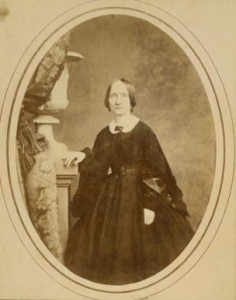
Ann Pamela Cunningham dedicated her life to the preservation of Mount Vernon, which became one of the first historic houses in America to be preserved specifically for public enjoyment. This model paved the way for the thousands of house museums that exist today in America. Image courtesy of Mount Vernon.
In 1853 Louisa Bird Cunningham passed by Mount Vernon on a steamboat headed down the Potomac River. Dismayed at the ruinous conditions of the former mansion, she wrote to her 37-year old daughter Ann Pamela that perhaps women could save and preserve Mount Vernon as a shrine to George Washington. Ann Pamela Cunningham took up this challenge, writing “An Appeal to the Ladies of the South” in December 1853. Widely reproduced in newspapers all over the South, it encouraged Southern women to lead efforts to save George Washington’s home, unless “pilgrims to the shrine of pure patriotism should find it forgotten, surrounded by blackening smoke and deafening machinery!”[iv] The idea soon caught on throughout the South and indeed in the North too. Cunningham, who as a childless and unmarried invalid dedicated her whole life to this effort, created the Mount Vernon Ladies Association which helped raise the $200,000 needed to purchase the estate in 1858. While the Civil War interrupted the house’s preservation, it has served as a house museum ever since.
Thanks to the legacy of Cunningham, historic house museums have become America’s most common public history site. As former National Trust for Historic Preservation (NTHP) President Richard Moe wrote in 2002, “Almost every American community of any size can boast at least one—and quite often more than one—house museum.”[v] In 2013, in a speech at the annual National Preservation Conference, current NTHP President Stephanie Meeks estimated that there are about 15,000 house museums in the country—the equivalent of about five for every American county.[vi] The oversaturation of this type of public history is not necessarily a good thing. Both Moe and Meeks mentioned the ubiquitousness of historic house museums to demonstrate that strong action is needed to redefine the best practices for house museums. In fact, Moe’s article was entitled “Are There Too Many House Museums?” Nevertheless, Cunningham’s actions still affect the field today. As Moe wrote, “The successful Mount Vernon campaign established a pattern that has since been followed by hundreds of preservation groups.”[vii] Moe’s successor echoed his comments. “Mount Vernon – where the house museum concept was conceived in our nation,” Meeks said, “established and forever legitimized a model” for public history.[viii] So while debates over the efficacy of Cunningham’s model exist, there is no doubt she had a tremendous influence on public history.
If house museums are America’s most common example of public history, the National Park Service (NPS) is the country’s largest and most visited collection of public history sites, with 1,769 museum facilities.[ix] The land area of the national park system is also staggering: 401 specific units, covering over 84 million acres in every state, Washington, D.C., American Samoa, Guam, Puerto Rico, and the U.S. Virgin Islands. According to its FAQ page, NPS received 273,630,895 visitors in 2013, which is equivalent to roughly 85% of America’s population.[x] Though not all of those visitors necessarily learned about history, there’s no doubt that public history and its related fields of archaeology, anthropology, preservation, and museology are ever-present characteristics of National Parks. The man most responsible for this focus is Horace Albright.
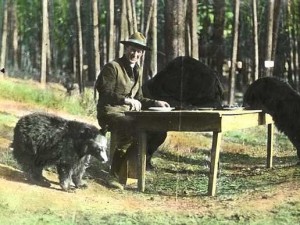
In this colorized photo slide from 1922, Yellowstone Superintendent Horace Albright enjoys a “bear dinner.” After his time as a Superintendent, Albright became National Park Service Director, where he added parks that focused on history rather than nature.
Image courtesy of National Park Service, Historic Photograph Collection.
Horace Albright joined the Interior Department at the age of 23 in 1913 and worked as an early employee of NPS after Congress authorized it in 1916. After serving as Assistant Director and then the Superintendent of Yellowstone, Albright was named the second Director of the Park Service in 1929 (two years into Mount Rushmore’s construction). In the early days of the Park Service, the vast majority of its holdings were large western parks, preserved and protected for their stunning natural scenery. Under Albright’s leadership, however, NPS added more parks in the eastern part of the country, and pushed for more focus on history in the parks, since history “served the public good, encouraging Americans to find their place in the nation.” The subsequent creation of a Park Service history program, “transformed vernacular landscapes and local traditions into components of a national heritage.”[xi] Specifically, in one of his last acts as Director, Albright successfully secured the transfer of 57 Civil War and Revolutionary War battlefields to the Park Service from the War Department, in 1933, after arguing that because “the interesting features of each of these parks are their historic associations” NPS should preserve them for future generations.[xii] This act “placed the importance of historical parks on par with natural parks.”[xiii] Under Albright’s directorship, the first two national monuments dedicated to history in the NPS were established, both in Virginia. Lastly, he created the Branch of Research and Education in 1931, which after many different transformations became the modern History Division.[xiv] As part of this process, he hired the first Chief Historian Verne Chatelain who executed Albright’s vision of expanding history in the parks after his retirement in 1933.
Albright’s legacy is still important today. The NPS training center at the Grand Canyon that educates rangers on public engagement is named after him, since he emphasized the importance of rangers doing public service. Also, NPS’s management of battlefields has made them great places of public history engagement. For example, according to one estimate, 15 National Park Service Civil War battlefields and historic sites in Missouri, Pennsylvania, South Carolina, Tennessee, and Virginia attracted an average of over one million visitors in 2010, on the eve of the Civil War sesquicentennial. And during the sesquicentennial, major battlefield sites have seen huge upticks in attendance. [xv] Perhaps without Albright, these Parks would not have been preserved by NPS for public enjoyment today. In the end, current Chief Historian Robert Sutton sums up Albright’s contributions very succinctly: “In many ways, Horace Albright was the most important person in National Park Service history.”[xvi]
Visiting house museums or national parks is one way the public interacts with history. There are also passive interactions, like reading books, listening to audio programs, and watching films about historical topics. This is where another definition of public history comes into effect. I like to think of public historians as translators; we “translate” the latest academic historical research and writing into easily understandable segments for a general audience. Perhaps no greater academic historian accomplished this than Allan Nevins.
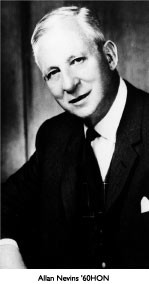
Allan Nevins always had the public in mind. His promotion of history through popular magazines, radio programs and accessible books connected the wider world with history, even as he maintained an academic post for most of his career.
Image courtesy of Columbia University.
Starting in 1929, Allan Nevins served as a historian at Columbia University for 30 years, as well as on the faculty of Oxford University. Despite these lofty academic credentials, he railed against the inaccessibility of academic history, while promoting the legitimacy of amateur history. Nevins crucially helped historians “bridge the perceived gap with the general public” by bringing together “leading amateurs and professionals in a crusade against pedantry.”[xvii] Though he was not the first to engage with the general reader, Nevins worked in several different mediums to make history accessible. He fostered the development of the American Heritage magazine, which by 1959 had similar circulation to Harper’s Magazine and Atlantic.[xviii] Through the Society of American Historians (SAH), which he helped found in 1939, Nevins produced radio and television productions of history, including the American Stories radio series that was distributed throughout the country.[xix] Lastly, Nevins was a prolific writer, publishing over 79 works throughout his career, including an extremely successful and popular textbook, America, the History of a Free People, which was published in several editions in the 1950s and 1960s.[xx] These publications, especially his eight-volume series on the Civil War, combined scholarly research with readable prose, and were widely read. Though Nevins ruffled some feathers in the process of bridging the gap of academic and popular history, his push to make history more accessible to the public was crucial. To honor his influence, SAH awards the Allan Nevins Prize to the best-written doctoral dissertation. So in some ways, anytime an academic historian writes a widely accessible book that the public greatly consumes, she is fulfilling the goal of Nevins.
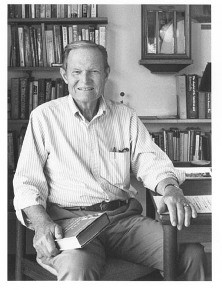
Robert Kelley found the modern Public History movement by creating the first graduate program at UC Santa Barbara in 1976. The National Council on Public History (which was founded in 1979) honors his legacy with the biannual Robert Kelley Memorial Award.
Image courtesy Of National Council on Public History.
Cunningham, Albright and Nevins are all very important figures in the history of public history. Yet, none of them called what they did “public history.” That term gained prominence thanks to Robert Kelley. Kelley served on the history faculty of the University of California, Santa Barbara from 1955-1993, retiring just months before his death in August 1993 at the age of 68. Yet his academic career did not solely define him. In addition to his faculty position, he also served as a legal consultant and expert witness for the California Attorney General, and during the Korean War served as an Air Force adjutant and historian. So he had plenty of non-traditional historical experience. Using this varied experience, Kelley created an experimental program in 1976 at UCSB in “Public History.” At the time, there was a growing jobs crisis for PhD holders, as American universities turned out new doctorates at a high rate that exceeded deman. In light of the doomed job opportunities, Kelley remembered his experiences as an expert witness earlier and applied for a Rockefeller Grant to institute a new program that would train PhD students to use history in non-academic settings. This created the modern movement, and was the biggest contribution of his career. “His frequent periods of off-campus engagement shaped his view of the relationship between the university and society,” one obituary wrote, “and led him to programmatic and curricular innovations that came atop a superbly successful career as an academic historian. For him, academic knowledge should be applied to the needs of society. This was the central dynamic in his career.”[xxi]
In addition to leading to an increase in the phrase “public history” (instead of “applied history” which used by a similar program at Carnegie Mellon), Robert Kelley helped found the Public Historian, and NCPH. Today, NCPH honors his legacy with the biannual Robert Kelley Memorial Award, which “honors distinguished and outstanding achievements by individuals, institutions, non-profit or corporate entities for having made significant inroads in making history relevant to individual lives of ordinary people outside of academia.”[xxii] Recent winners can be considered the heirs of Cunningham, Albright, and Nevins, as they’ve directed presidential museums, served as NPS Chief Historian, and bridged the gap between public and academic history. Authors who argue for a longer genealogy of public history, such as myself via my Mount Rushmore, agree that Robert Kelley founded the modern Public History movement.
So there you have it, a Public History Mount Rushmore: Ann Pamela Cunningham, who fought to preserve the first President’s house as America’s first house museum; Horace Albright, who pushed the boundaries, literally, of the National Park Service to interpret and preserve historical landmarks for the public; Allan Nevins, who used his position of an academic appointment to make history more relatable; and Robert Kelley, who fathered the modern movement that gives us the framework for understanding the other three.
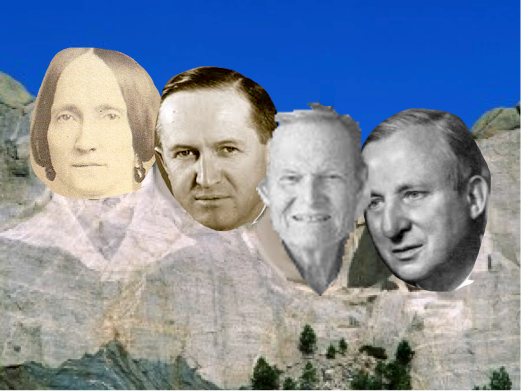
A Public Historian Mount Rushmore (l-r): Ann Pamela Cunningham, Horace Albright, Robert Kelley, and Allan Nevins.
[i] “Frequently Asked Questions,” Mount Rushmore National Memorial website, accessed December 6, 2014, http://www.nps.gov/moru/faqs.htm.
[ii] In 2013 the Nationals also added William Taft, the first president to throw out a first pitch on Opening Day.
[iii] Cathy Stanton, “‘What Is Public History?’ Redux,” Public History News, 27:4 (September 2007) via Robert Wieble “Defining Public History: Is It Possible? Is It Necessary?” Perspectives on History March 2008, accessed December 4, 2014, http://www.historians.org/publications-and-directories/perspectives-on-history/march-2008/defining-public-history-is-it-possible-is-it-necessary.
[iv] Patricia West, Domesticating History: The Political Origins of America’s House Museums (Washington: Smithsonian Institution Press, 1999), 7.
[v] Richard Moe, “Are There Too Many House Museums?” Forum Journal, 16:3 (Spring 2002), 4.
[vi] Stephanie Meeks “House Museums: A 20th Century Paradigm,” (speech, Indianapolis, October 30, 2013), http://www.preservationnation.org/who-we-are/press-center/speeches-op-eds/speech-house-museums.html.
[vii] Moe, “Are There Too Many House Museums?” 4.
[viii] Meeks, “House Museum.”
[ix] I tried to find out the total number of “house museums” in the National Park Service. However, they do not classify their museums as such, since it’s hard to distinguish between a fully furnished house with original materials, a partially furnished house, and a house with reproduction furnishings. But according to Ron Wilson, Chief Curator of NPS, “326 parks have 1,769 museum facilities and we have NPS museum collections in 587 partner facilities.” [NPS Chief Historian Robert Sutton, e-mail message to author, December 8, 2014.]
[x] Both land area and visitation from “Frequently Asked Questions,” National Park Service, accessed December 6, 2014, www.nps.gov/faqs.htm.
[xi] Both quotes from Denise Meringolo, Museums, Monuments and National Parks: Toward a New Genealogy of Public History, (Amherst, MA: University of Massachusetts Press, 2012), 86.
[xii] Meringolo, Museums, Monuments, and National Parks, 90, 111-12.
[xiii] Robert Sutton, e-mail message to author, December 8, 2014.
[xiv] Organization of American Historians, Imperiled Promise: The State of History in the National Park Service, prepared by Anne Mitchell Whisnant, Marla R. Miller, Gary B. Nash, David Thelen, (Bloomington IN: Organization of American Historians, 2011), 23.
[xv] The Harbinger Consulting Group, “Economic Benefits of Civil War Battlefields: Summary of Existing Data and Analysis,” published by Civil War Trust, April 2012, page 4. Nick Sacco “Analyzing Visitor Attendance to Civil War Sites During the Sesquicentennial,” Exploring the Past (blog), April 28, 2014 http://pastexplore.wordpress.com/2014/04/28/analyzing-visitor-attendance-to-civil-war-sites-during-the-sesquicentennial/.
[xvi] Robert Sutton, e-mail message to author, December 8, 2014.
[xvii] Ian Tyrrell, Historians in the Public: The Practice of American History, 1890-1970 (Chicago: The University of Chicago Press, 2004), 61.
[xviii] Tyrrell, Historians in the Public, 67.
[xix] Tyrrell, Historians in the Public, 103.
[xx] Peter Charles Hoffer, Past Imperfect: Facts, Fictions, Fraud—American History from Bancroft and Parkman to Ambrose, Bellesiles, Ellis, and Goodwin (New York: Public Affairs, 2007), 44-45.
[xxi] Otis L. Graham, “Robert L. Kelley, History: Santa Barbara,” in University of California: In Memoriam, 1994, edited by David Krogh. (Oakland: University of California, 1994), 146, accessed via http://texts.cdlib.org/view?docId=hb5g50061q;NAAN=13030&doc.view=frames&chunk.id=div00056&toc.depth=1&toc.id=&brand=calisphere.
[xxii] “Robert Kelley Memorial Award,” NCPH website, accessed December 6, 2014, http://ncph.org/cms/awards/robert-kelley-memorial-award/